By Frank Jesse
Savasana (corpse pose) is a much misunderstood yoga pose. It is usually the last pose in our Iyengar yoga practice or class and, while many students look forward to lying down and relaxing their muscles in Savasana, especially after a demanding asana session, others don’t understand its purpose. Some prefer to skip Savasana, or make it as short as possible.
While Savasana requires no physical effort it can be one of the most difficult yoga poses to master. Students will find that they either fall asleep, go into a dreamy state or otherwise find their mind thinking and planning for such mundane things as the grocery shopping, or worrying about work.
But mastering Savasana is as important as mastering any other pose in Iyengar yoga.
Why?
Savasana is about letting go and being present, letting go of tension, thoughts, distractions, memories, ideas……. In the more active asanas we focus on various techniques to align and maintain the correct support. In Savasana, after the initial careful placement of our body, no effort is required and the breathing is completely natural.
In Savasana there is no room for competition. The ego needs to completely surrender. We are in a space where it really doesn't matter what any one else is doing in the class.
In a deep Savasana, the experience can be as though you are the only being lying on planet Earth. Nothing else matters and we are not disturbed by external stimuli. As we learn to surrender, our thoughts literally die away and we find ourselves in a quiet space between sleep and effort, devoid of the normal filters with which our mind perceives the world through memory and prejudices acquired through previous experience. A state of pure unconditional existence pervades.
Savasana is our bridge
While Savasana rests our body and mind after the effort and focus required during asana practice, it’s also like a bridge between our practice and every day life. In Savasana we learn to absorb the benefits of our practice in deeper way. Savasana also feeds into our practice. While the asanas require effort to varying degrees, all require the quality of surrender that we learn in Savasana. Perfection in asana comes with a state of effortless effort, where the physical effort is balanced with a calm, focused mind and quiet even breathing, qualities learnt in savasana
Conclusion
Let us finish with the words of BKS Iyengar on Savasana: “ By remaining motionless for some time and keeping the mind still while you are fully conscious, you learn to relax. This conscious relaxation invigorates and refreshes both body and mind. But it is much harder to keep the mind than the body still. Therefore, this apparently easy posture is one of the most difficult to master."
Source: Light on Yoga by BKS Iyengar
The Practice
1. Lie down on the floor a little away from the wall so when you straighten your legs your feet don't touch the wall. Ideally, place a blanket over your sticky mat so you stay warm and your body can release completely.
2. Have a small blanket folded to support the head and neck just high enough to keep the forehead slightly higher than the chin. The head and neck should never arch back. Do not allow your head to turn to the side.
3. Be sure to draw the shoulder blades down the back and open the chest towards the chin. Have the arms a comfortable distance from the body without fully stretching them to the sides but also not tucked in too close to the sides of the waist. Allow your arms to roll out so your palms face up and completely relax your fingers.
4. Before straightening your legs, lift and extend the buttocks to your heels so that your whole sacrum rests on the floor and your lower back rests into the floor with a slight but normal arch. If you press the lower back to the floor, the chest won’t open fully. Keep your abdomen soft and relaxed.
5. Slowly stretch the legs out straight one at the time without disturbing the position of the pelvis or lower back. Allow your legs to roll out to the side from the hips to the feet. Check that your body is in a straight line and you are resting as evenly on the left and right sides.
6. After aligning your bogy in a straight line so you are comfortable and relaxed, resist the temptation to keep readjusting. Stay perfectly still and quiet and be aware of your body relaxing deeply into the floor.
7. At first you may have the sensation of the legs and arms feeling heavy as they sink down but as you relax more deeply they will feel light and spacious.
8. Allow your eyes to rest completely, so they sink deeper towards the back of the skull and you have a sense they are focusing inwardly towards your heart. Your tongue should be relaxed and still. The lower jaw is completely relaxed, and the back of the neck supported centrally on the folded blanket. Allow your ears to relax, inner ear receding.
9. Be aware of your breath, quiet and soft. As you let go of your breath with the exhalation feel any tension or thoughts pass away.
10. Stay 5 to 20 minutes. To come out, first roll to your right side and wait there for a short time before sitting up.
11. Enjoy your day!
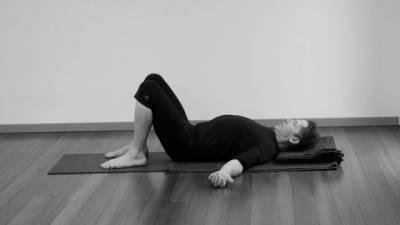
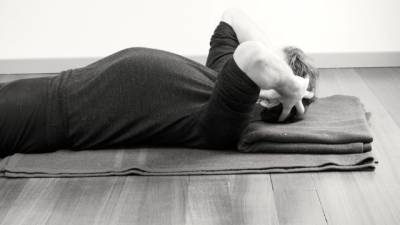
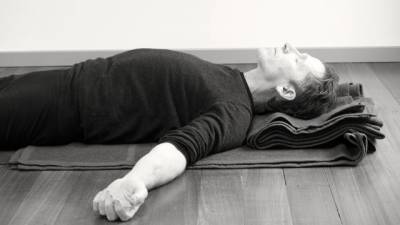
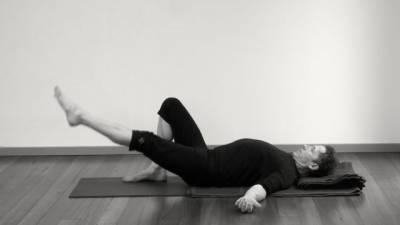
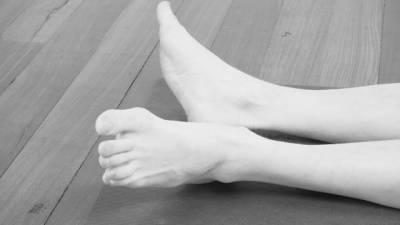
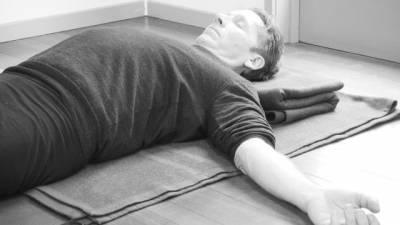
Join over 2,000 of your peers and get fortnightly articles delivered to your in box.